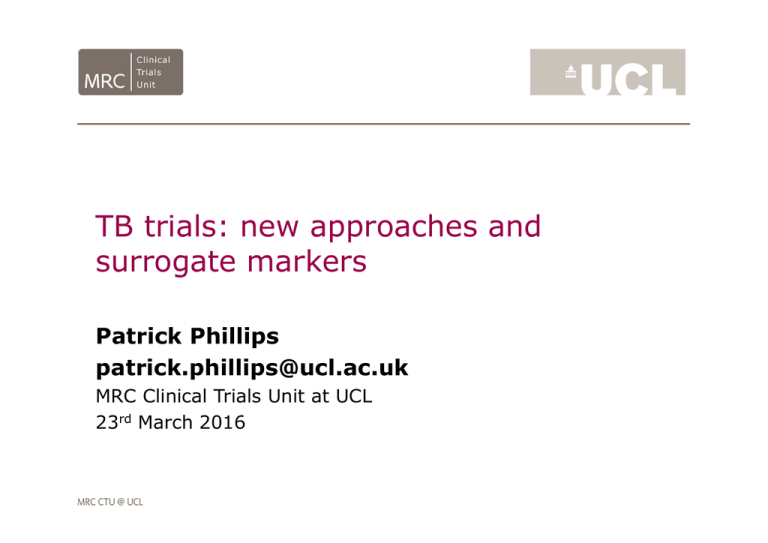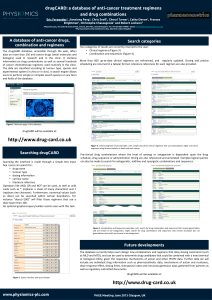TB trials: new approaches and surrogate markers Patrick Phillips
advertisement

TB trials: new approaches and surrogate markers Patrick Phillips patrick.phillips@ucl.ac.uk MRC Clinical Trials Unit at UCL 23rd March 2016 Outline • Why do we need better tools for regimen development? • The STEP Phase IIC trial design • STEP in practice: The PanACEA consortium 1. Phillips PPJ, Mendel CM, Burger DA, et al: Limited role of culture conversion for decision-making in individual patient care and for advancing novel regimens to confirmatory clinical trials. BMC Medicine 2016, 14(1):19. 2. Phillips PPJ, Dooley KE, Gillespie SH, et al: A new trial design to accelerate tuberculosis drug development: The Phase IIC Selection Trial with Extended Post-treatment follow-up (STEP). BMC Medicine 2016 Why do we need better tools for regimen development? • 4594 patients randomised • $100m? • 4 novel 4-month regimens • 0 regimens noninferior Nimmo, Lipman M, Phillips PPJ, McHugh T, Nunn A, Abubakar I. Shortening treatment of tuberculosis: lessons from fluoroquinolone trials. The Lancet Infectious Diseases 2015; 15(2): 141-3. C Where is the bottleneck? Phase I: Safety Phase IIA: Dose selection Phase IIB: Exploratory efficacy Middle Development • Small studies, often healthy volunteers • Primary objective is to rule out gross toxicities • Identify optimal dose or doses • Select most promising regimens for Phase III evaluation Phase III: Confirmatory (non-inferiority) • Large, expensive • Yield robust evidence to convince regulators and change policy and practice Where is the bottleneck? ‘Culture positive’ Time to culture conversion ‘Culture negative’ Time to culture conversion is a poor predictor of 18-month outcome Phillips PPJ, Mendel CM, Burger DA, et al: Limited role of culture conversion for decision-making in individual patient care and for advancing novel regimens to confirmatory clinical trials. BMC Medicine 2016, 14(1):19. Time to culture conversion is a poor predictor of 18-month outcome • • • • Strong association Treatment effect independent of time to culture conversion Non-zero asymptotes Time to culture conversion doesn’t fully capture treatment differences Phillips PPJ, Mendel CM, Burger DA, et al: Limited role of culture conversion for decision-making in individual patient care and for advancing novel regimens to confirmatory clinical trials. BMC Medicine 2016, 14(1):19. Optimising middle development: Reducing the risk of expensive phase III failure Phase I: Safety Phase IIA: Dose selection Phase IIB: Exploratory efficacy Middle Development Phase III: Confirmatory (non-inferiority) Optimising middle development: Reducing the risk of expensive phase III failure Phase I: Safety Phase IIA: Dose selection Phase IIB: STEP Exploratory Phase IIC: efficacy Bridging the gap Middle Development Phase III: Confirmatory (non-inferiority) Traditional Phase IIB trial for novel TB regimens (PanACEA MAMS-TB) • • N=80-100 per arm Primary endpoint • Culture conversion to 12 weeks The Phase IIC Selection Trial with Extended Posttreatment follow-up (STEP) End treatment on experimental regimens after 4 (or 3) months The Phase IIC Selection Trial with Extended Posttreatment follow-up (STEP) End treatment on experimental regimens after 4 (or 3) months 12 months postrandomisation follow-up for relapse • • • N=80-100 per arm Primary endpoint • Culture conversion to 3-4 months Secondary endpoint • Long-term cure with absence of relapse STEP Phase IIC design • Novel treatments given for their intended duration in phase II • Patients followed to 12 months post-randomisation Primary endpoint: Time to culture conversion Adequate power to detect differences between regimens Intermediate endpoint that only partially reflects long-term clinical outcome Secondary endpoint: Long-term relapse-free cure Trial underpowered to detect differences in relapse rates Patient-relevant clinical outcome Decision-making for progression to phase III • Critical question at phase II: • Will this regimen succeed in phase III? • What is the probability that this shorter regimen will have efficacy at least as good as the 6-month control in a future phase III trial? • Naturally fits into a Bayesian framework • Predictive probability that the unfavourable proportion ≤ p1 in a hypothetical future phase III trial Bayesian predictive probabilities Sceptical prior (solid lines), Flat prior (dashed lines) Phillips PPJ, Dooley KE, Gillespie SH, et al: A new trial design to accelerate tuberculosis drug development: The Phase IIC Selection Trial with Extended Post-treatment follow-up (STEP). BMC Medicine 2016, ‘Traffic light system’ for Bayesian predictive probabilities, for some p1 What would a STEP Phase IIC trial added prior to the RIFAQUIN phase III trial? • 10,000 random draws from RIFAQUIN trial data with sample sizes 60,80, 100. STEP in practice: The PanACEA Consortium Conclusions • New tools are needed to more efficiently deliver new regimens. • Culture conversion during treatment has only a limited role in decision-making for advancing regimens into phase III trials. • Collection of definitive clinical outcome data in a relatively small number of participants over only 12 months provides valuable information about the likelihood of success in a future phase III trial. • The STEP Phase IIC trial design is an important tool that allows for more informed decision-making and accelerates regimen development. Acknowledgements • Limited role of culture conversion for decision-making in individual patient care and for advancing novel regimens to confirmatory clinical trials. BMC Medicine 2016, 14(1):19. • Carl Mendel, Divan Burger, Angela Crook, Andrew Nunn, Rod Dawson, Andreas Diacon, Stephen Gillespie • A new trial design to accelerate tuberculosis drug development: The Phase IIC Selection Trial with Extended Post-treatment follow-up (STEP). BMC Medicine 2016 • Kelly Dooley, Stephen Gillespie, Norbert Heinrich, Jason Stout, Payam Nahid, Andreas Diacon, Rob Aarnoutse, Gibson Kibiki, Martin Boeree, Michael Hoelscher



